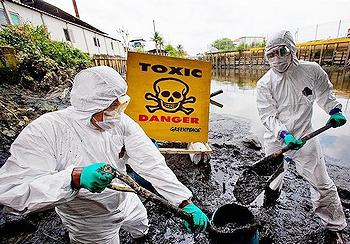Thailand's rivers polluted by factory and residential waste
 0 Comment(s)
0 Comment(s) Print
Print E-mail
China.org.cn, September 27, 2011
E-mail
China.org.cn, September 27, 2011
Thailand's rivers are being increasingly polluted by industrial wastewater and solid waste dumping, but activists and residents say the Thai government has no clear strategy for water pollution prevention.
 |
|
Greenpeace activists in protective suits, collect samples of sediments from Samrong canal in an industrial district of Samutprakan province, August 2010. [Greenpeace] |
In the past, Thais have not been exposed to much industrial pollution in rivers, and many did not pay attention to preserving and recycling water because shortages were uncommon. Thailand has been fortunate to have an abundant supply of fresh water, but clean water advocates say the time for complacency is over.
A January 2011 Greenpeace report, "Hidden Consequences," drew attention to the 30,000 industrial facilities along the Chao-Phraya River, which runs through Thailand's major cities, including the capital, Bangkok, a city of 12 million people.
Two months later, an ABAC public opinion poll surveyed 1,550 Thai residents living in three major industrial districts, and found that 74 percent were worried about toxic chemical contamination in their waterways.
A critical test of pollution is the analysis of dissolved oxygen. The Pollution Control Department of Thailand reported a level in August 2010 of one milligram per liter in the lower part of the Chao Phraya, which compares to a normal range of between three and six mg/l.
Samrong Canal is located in Samutprakan province south of the Bangkok Metropolitan Region, notorious for being one of the most polluted residential waterways in Thailand.
The canal is used to dump waste by a variety of metal plating, chemical, plastics and textile dyeing factories. It has a very low dissolved oxygen content, combined with the presence of hazardous substances such as heavy metals, nonylphenols, and the carcinogen 2-naphthylamine.
Preeyanooch Siripojjanawan, 43, who has been living alongside Samrong for seven years, said "In the early days the water was much better, but a few years later it started giving off a bad smell every time the waste was dumped."
While the main concern is wastewater released from factories, untreated sewage from residential areas is another problem. This effluent may not be as worrying to residents as industrial pollutants but the risk should not be underestimated, as it is a carrier of many diseases including typhoid.
According to a World Health Organization report, diarrhea caused by this type of contaminated water causes 2.2 million deaths each year worldwide.
Improper residential solid refuse disposal is another factor that can degrade the condition of river water.
"Every week local refuse collectors would collect household rubbish but most of the bins were not full because people just dumped the bagged domestic waste straight into the canal," says Siripojjanawan.
Regulations for waste contamination and treatment for industry, issued back in 1992, have not been effective, and some residents have complained about these industrial polluters, requesting the authorities protect their neighborhoods.






Go to Forum >>0 Comment(s)